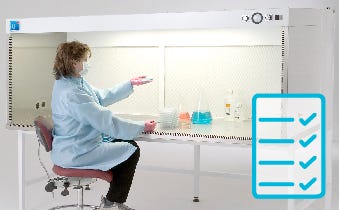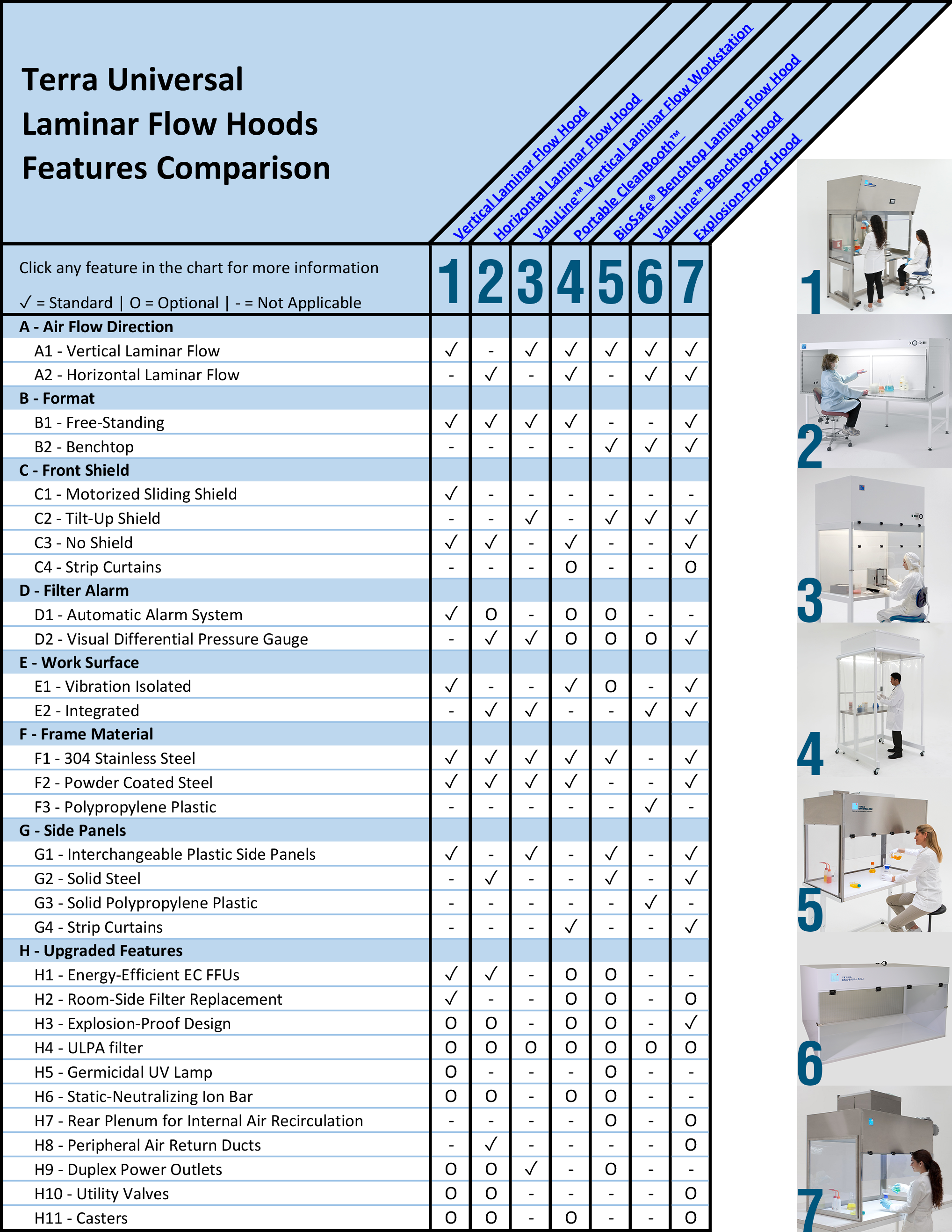- +1 (714) 578-6100
Hours Mon - Fri, 07:00 AM - 06:00 PM (Pacific Time)

Laminar Flow Hoods Features Comparison
Posted:
February 19, 2021

A – Air Flow Direction
(back to chart)
There are compelling reasons to choose either airflow system depending on clearance requirements, process location, work surface design, and operator safety. Below is a brief comparison (read more on horizontal vs vertical laminar flow hoods).
A1 – Vertical Laminar Flow: Vertical laminar flow hoods are often selected because they resemble, on a smaller scale, the design of a laminar flow cleanroom, in which fan/filter units (FFUs) are typically positioned in the ceiling
Advantages
- Design fits within a smaller footprint, encompassing less work space.
- Isolated work surface and anti-vibration tables are available for vibration-sensitive work.
- Easier to configure for tall equipment or processes requiring more vertical space.
- The filter, installed above the work surface, is more accessible for maintenance and testing.
A2 – Horizontal Laminar Flow: A horizontal-flow hood requires additional depth to accommodate the rear-mount FFUs with some additional rear clearance to allow air to enter the system. These clearance requirements necessitate a deeper bench and more floor space than a vertical flow system.
Advantages
- Laminar airflow is parallel to work surface, reducing turbulent effects that can occur from vertical airflow striking perpendicular to work surface.
- Easier to position and stagger sterile equipment and materials on work surface closer to the filter face (upstream from other potential contaminants).
- Hands and gloves can rest downstream of samples, less likely to contaminate operations.
B – Format
(back to chart)
B1 – Free-Standing: Free-standing or floor mounted laminar flow hoods are larger in size, mimicking a mini-cleanroom setup. They are more suitable for large equipment or processes that require more open space. Free-standing laminar flow hoods are also generally more suitable for vibration sensitive applications, since they can be configured with a separate work table inside the hood.
B2 – Benchtop: Benchtop laminar flow hoods are generally smaller in size and therefore can offer greater portability to move and mount onto different work surfaces. They may, however, pose a problem for vibration sensitive applications such as microscopy. Certain benchtop laminar flow hoods are available with vibration isolation stands to alleviate this problem.
C – Front Shield
(back to chart)
C1 – Motorized Sliding Shield: Motorized access shields are designed for large, free-standing vertical laminar flow hoods to help improve laminar flow. The position can be lowered to allow partial access to perform work while simultaneously maintaining a protected laminar flow environment. The automatic sliding shield is rated for millions of operations and is connected to a touch-screen PLC controller for easy operation.
C2 – Tilt-Up Shield: Manual tilt-up shields offer a low-cost access and protection solution for laminar flow hoods. The shield helps preserve laminar airflow while simultaneously providing sufficient access to work inside the hood. A hinged shield also allows for easy equipment access and maintenance. They are included with most benchtop hoods and some free-standing hood designs.
C3 – No Shield: Depending on airflow direction, a shield can sometimes inhibit laminar airflow or access to equipment. Some applications using horizontal laminar flow hoods forgo a shield to improve laminar airflow that runs parallel to the work surface.
C4 – Strip Curtains: Strip curtains are designed for large free-standing laminar flow clean booths or mini-cleanrooms. They can drape from ceiling to floor, making them suitable as barriers or entryways for personnel or large equipment. They are also easy to replace and available in several material types, such as ESD safe, non-outgassing, and opaque formulations.
D – Filter Alarm
(back to chart)
D1 – Automatic Alarm System: Filter replacement alarm systems provide automatic replacement alerts to avoid costly and unexpected operational interruptions. They can also improve safety by preventing electrical/fire hazards caused by overworked motors pushing against overloaded HEPA filters. Free-standing vertical laminar flow stations include a programmable filter back-pressure alarm that is integrated into a touch-screen PLC panel. Other laminar flow hoods can be configured with Terra’s add-on filter replacement alarm system. The add-on system also allows control of the differential pressure set-point to adjust frequency of filter replacement. It includes a visual differential pressure gauge, visual flashing indicator light, and an audible buzzer with silencer that sounds when set point level is exceeded.
D2 – Visual Differential Pressure Gauge: Stand-alone visual differential pressure gauges can be configured to most laminar flow hoods to help monitor and control airflow in a laminar flow hood. This simple monitoring device with a low up-front cost helps confirm the hood is operating and supplying proper airflow. However airflow control and filter replacement monitoring can be more susceptible to human error since the stand-alone pressure gauge does not include an automatic alarm system.
E – Work Surface
(back to chart)
E1 – Vibration Isolated: Laminar flow hoods compatible with vibration isolated work surfaces can be configured to fit a separate work table inside the hood. They are recommended for vibration sensitive applications such as microscopy.
E2 – Integrated: Laminar flow hoods with built-in cleanroom-compliant work surfaces can enhance cleanliness and safety. Because the attached workstation transmits fan vibration, this design is not recommended for delicate operations with microscopes, scales, balances, or other precision instruments.
F – Frame Material
(back to chart)
F1 – 304 Stainless Steel: 304-grade stainless steel resists most harsh chemicals and alcohol-based cleaning agents, and won’t produce contaminants during sterilization.
F2 – Powder Coated Steel: Powder-coated steel offers a lower cost alternative to stainless steel that is still more durable and rigid than plastic designs. Powder-coated steel has slightly lower chemical and moisture resistance compared to stainless steel.
F3 – Polypropylene Plastic: Opaque polypropylene is most suitable for wet chemistry applications. It offers excellent chemical resistance against common acids, solvents, and disinfectants. The solid polypropylene frame features continuous-seam welds for easy cleaning and maximum protection against chemical splashes and spills.
G – Side Panels
(back to chart)
G1 – Interchangeable Plastic Side Panels: Removable side-panels increase the versatility of your hood by improving visibility and/or simplifying equipment access and maintenance. The side-panels are lined with foam gasket and slide into the hood’s frame for a simple yet effective sealed fit, free of troublesome fasteners or screws. Side panels can also be configured with application specific materials to help support required conditions inside the hood, such as:
- Visibility
- Light sensitivity
- Electrostatic discharge (ESD) safety
- Chemical resistance
- Thermal extremes
Below is a list of standard side-panel materials:
- Clear Acrylic
- Static-Dissipative PVC (SDPVC)
- Polycarbonate
- Black Acrylic
- Amber Acrylic
- FM4910 Polypropylene
- FM4910 CPVC
- White Acrylic
G2 – Solid Steel: Laminar flow hoods with solid steel walls are most suitable for critical cleanliness applications that require frequent disinfection. The design simplifies cleaning by minimizing cracks and crevices where particles or germs can collect.
G3 – Solid Polypropylene Plastic: Polypropylene hoods are most suitable for wet chemistry applications. The solid polypropylene frame and walls feature continuous-seam welds for easy cleaning and maximum protection against chemical splashes and spills.
G4 – Strip Curtains: Strip curtains are designed for large free-standing laminar flow clean booths or mini-cleanrooms. They can drape from ceiling to floor, making them suitable as barriers or entryways for personnel or large equipment. They are also easy to replace and available in several material types, such as ESD safe, non-outgassing, and opaque formulations.
H – Upgraded Features
(back to chart)
H1 – Energy-Efficient EC FFUs: Energy efficient FFUs offer lower operating costs, longer service life, and precision control of fan speed.
H2 – Room-Side Filter Replacement: Room-side replaceable (RSR) filters drastically simplify filter replacement. These filters can be easily removed and replaced without disassembling the bulky FFU from the hood. RSR filters feature a gel-seal to form a tight seal against the "knife-edge" on the blower housing.
H3 – Explosion-Proof Design: An explosion-proof laminar flow hood is designed to work in hazardous areas with risk of ignition due to flammable fumes or explosive dusts. All electrical components in explosion-proof hood designs are rated compliant for hazardous locations Class I, Division 1, Groups C & D and Class II, Division 1, Groups F ∓ G. This includes the fan filter unit (FFU), LED lights, wiring, and on/off switches.
H4 – ULPA filter: HEPA filters are rated 99.99% efficient at filtering particles down to 0.3 microns. ULPA filters are rated 99.999% efficient at filtering particles down to 0.12 microns. ULPA filters are suitable for achieving sub-class 100 particle counts. However due to the denser filter media, ULPA filters have more restricted airflow which can negatively affect flow rate and air changes per hour (ACH) within the work area.
H5 – Germicidal UV Lamp: UV lights can be built into laminar flow hoods to help decontaminate the hood after use. The UVC disinfection Module includes a timer plus "exposure switch" to protect users from exposure to harmful UV light.
H6 – Static-Neutralizing Ion Bar: Intrinsically safe low-voltage ionizing bars mount to a fan/filter unit inside a laminar flow hood to neutralize static charges that can lead to electro-static discharge and particle attraction. These units emit equal numbers of positive and negative ions and require no calibration or adjustments. The narrow profile minimizes any disruption to laminar flow inside the hood.
H7 – Rear Plenum for Internal Air Recirculation: An adjustable rear plenum on the back wall of the hood recirculates air to minimize turbulence in the work area and extend filter life.
H8 – Peripheral Air Return Ducts: Return air ducts help maintain laminar flow and keep particles out. Horizontal laminar flow stations feature return ducts along the bottom and side edges of the front opening. These ducts reduce backwash caused by placing objects near the work surface edge, a common source of turbulence inside a clean bench. On less sophisticated systems, an object placed near the front edge of a horizontal air-stream interrupts the laminar flow and provides an opportunity for unfiltered air to wash back into the work area, bringing contaminants with it.
H9 – Duplex Power Outlets: GFCI power receptacles installed on the interior of the hood provide operational convenience. Alternative mounting locations can be specified at time of order.
H10 – Utility Valves: Ball valves (petcocks) are available for utilities such as nitrogen, compressed air, vacuum, DI water, or other process gases. Valves are available in chrome-plated steel or ABS plastic.
H11 – Casters: Casters offer greater mobility for free-standing hoods. They allow hassle-free movement to different locations and facilitate cleaning under and around the work area.
Terra Universal is the leading expert in the design and fabrication of ISO rated cleanrooms, furnishing and supplies.
Get a free consultation from one of our cleanroom specialists:
Call (714) 459-0731


